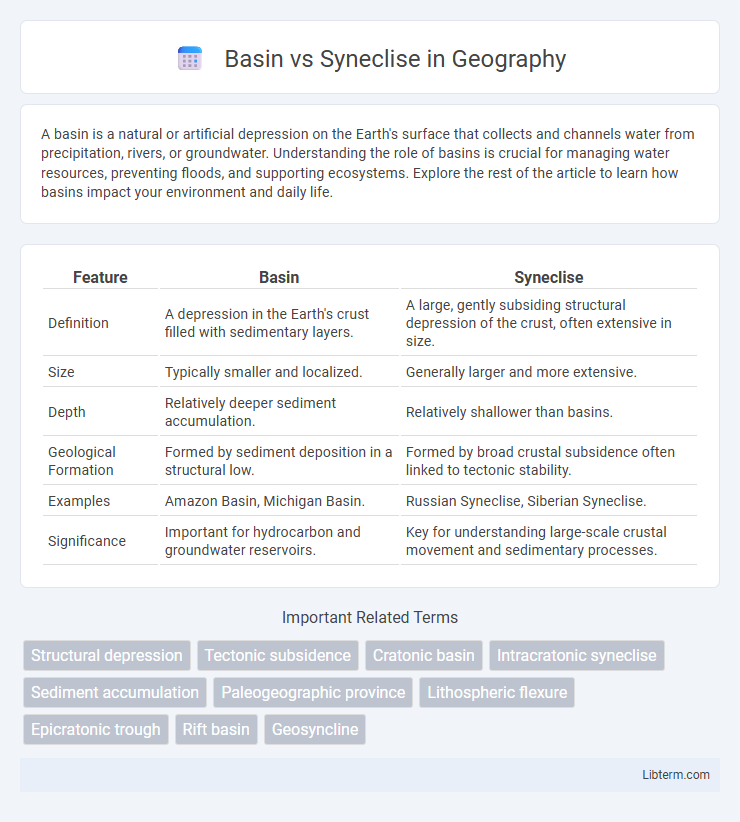A basin is a natural or artificial depression on the Earth's surface that collects and channels water from precipitation, rivers, or groundwater. Understanding the role of basins is crucial for managing water resources, preventing floods, and supporting ecosystems. Explore the rest of the article to learn how basins impact your environment and daily life.
Table of Comparison
| Feature | Basin | Syneclise |
|---|---|---|
| Definition | A depression in the Earth's crust filled with sedimentary layers. | A large, gently subsiding structural depression of the crust, often extensive in size. |
| Size | Typically smaller and localized. | Generally larger and more extensive. |
| Depth | Relatively deeper sediment accumulation. | Relatively shallower than basins. |
| Geological Formation | Formed by sediment deposition in a structural low. | Formed by broad crustal subsidence often linked to tectonic stability. |
| Examples | Amazon Basin, Michigan Basin. | Russian Syneclise, Siberian Syneclise. |
| Significance | Important for hydrocarbon and groundwater reservoirs. | Key for understanding large-scale crustal movement and sedimentary processes. |
Understanding Basins and Syneclises: An Overview
Basins and syneclises are large-scale geological depressions formed by the subsidence of the Earth's crust, with basins typically being bowl-shaped structures that accumulate thick sedimentary layers, while syneclises represent more extensive, elongated troughs often linked to regional tectonic downwarping. Both features are crucial in hydrocarbon exploration as they serve as significant sediment traps and potential reservoirs for oil and natural gas. Understanding their formation, sediment deposition patterns, and structural differences helps geologists predict resource distribution and assess basin evolution.
Geological Definitions: Basin vs Syneclise
A basin is a large-scale depression in the Earth's crust, typically characterized by sediment accumulation and subsidence, often forming structural, sedimentary, or tectonic basins. Syneclise refers to a broad, gently downwarped area of the crust, typically larger and less steep than a basin, often associated with stable, intracratonic regions and extensive sedimentary sequences. While both involve crustal downwarping, basins generally exhibit more localized and pronounced subsidence, whereas syneclises represent extensive, gentle warps with regional geological significance.
Formation Processes of Basins
Basins form primarily through tectonic subsidence, sediment accumulation, and crustal deformation processes such as rifting, flexure, or sagging. These depressions develop when the Earth's lithosphere stretches or cools, causing it to thin and sink, allowing sediments to infill over geological time. In contrast, syneclises represent large-scale, gently warped downwarps with extensive sedimentary cover, but basins are typically more localized and exhibit active tectonic and depositional processes driving their formation.
Development and Characteristics of Syneclises
Syneclises are extensive, gently folded sedimentary basins characterized by broad, shallow depressions spanning hundreds of kilometers, often forming in stable cratonic areas. Their development involves slow subsidence and sediment accumulation over long geological periods, leading to thick sequences of unmetamorphosed sedimentary rocks. Unlike typical basins, syneclises exhibit low tectonic activity and lack sharp structural deformation, making them crucial for understanding passive margin evolution and hydrocarbon potential.
Structural Differences: Basin vs Syneclise
A basin is a structural depression with rocks dipping inward from all sides toward a central point, typically forming circular or elliptical shapes, while a syneclise is a large-scale, gently subsiding structural trough with a broad, shallow curvature extending over hundreds of kilometers. Basins often exhibit more pronounced folding and faulting patterns due to localized subsidence, whereas syneclises show extensive regional downwarping with less intense deformation. The key structural difference lies in scale and curvature, with basins having steeper, more defined inward dips and syneclises characterized by widespread, gentle synclinal folds.
Sedimentary Features in Basins and Syneclises
Sedimentary features in basins commonly include thick accumulations of clastic and carbonate deposits that reflect prolonged subsidence and accommodation space, often exhibiting well-developed stratification and diverse facies indicative of varying depositional environments. Syneclises, being large-scale downwarped sedimentary basins, typically show extensive, gently dipping sedimentary layers with widespread, relatively uniform facies distribution and less tectonic disturbance compared to smaller basins. Both settings preserve substantial sedimentary thickness, but syneclises emphasize broad, shallow marine to continental deposits shaped by regional subsidence without intense deformation.
Major Examples Around the World
Major examples of basins include the Amazon Basin in South America, the Bengal Basin in South Asia, and the Michigan Basin in North America, characterized by sediment accumulation and relatively shallow subsidence. Syneclises, which are large-scale, gently subsiding structural depressions, are exemplified by the West Siberian Syneclise in Russia and the Parnaiba Syneclise in Brazil, often representing extensive, stable platforms with thick sedimentary sequences. Both geological features serve as significant hydrocarbon and groundwater reservoirs due to their unique tectonic and depositional settings.
Economic Importance: Resources and Utilization
Basins are often rich in hydrocarbon resources like oil and natural gas due to their sedimentary deposits, making them critical for energy extraction industries and economic development. Syneclises, though structurally similar to basins, generally have deeper sedimentary layers that can contain significant mineral resources including coal, shale gas, and metallic ores, supporting mining and energy sectors. Both geological structures contribute to regional economies through resource extraction, influencing infrastructure investment and trade.
Comparative Analysis: Basin vs Syneclise
Basins are sedimentary depressions characterized by thick accumulations of sediments and relatively smaller areal extent, whereas syneclises represent large-scale downwarps with widespread, gently dipping sedimentary layers. Basins often form through localized subsidence due to tectonic or sedimentary processes, while syneclises emerge from broader regional structural downflexing associated with crustal movements. Comparative analysis highlights that basins typically exhibit more pronounced sedimentary thickness variations and stratigraphic layering, contrasting with the more uniform sedimentary cover and broader dimensions found in syneclises.
Conclusion: Key Takeaways and Future Perspectives
Basins are typically smaller, tectonically stable sedimentary depressions, whereas syneclises encompass larger, more regional-scale downwarped structures often linked to significant sediment accumulation. Understanding their distinct geological formations aids in exploration strategies for hydrocarbon and mineral resources, with basins providing localized depositional environments and syneclises indicating extensive sedimentary regimes. Future research integrating advanced seismic imaging and geochemical analysis will enhance resource assessment and clarify basin-syneclise evolution within varying tectonic contexts.
Basin Infographic

 libterm.com
libterm.com